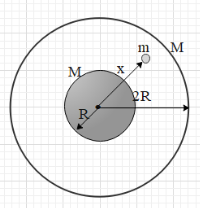
A uniform sphere of mass M and radius R is surrounded by a concentric spherical shell of same mass but radius 2R. A point mass m is kept at a distance x (> R) in the region bounded by spheres as shown in the figure. The net gravitational force on the particle is

A. $\dfrac{GMm}{{{x}^{2}}}$
B. $\dfrac{GMmx}{{{R}^{2}}}$
C. $\dfrac{G(M+m)}{{{x}^{2}}}$
D. zero

Answer
556.2k+ views
Hint: First, calculate the gravitational force that the solid sphere exerts on the given point mass by using the formula for gravitational force. Then use the concept of shell theory and calculate the force exerted by the shell.
Complete step by step answer:
Let us first calculate the force exerted on the mass m by the solid sphere. The gravitational force on a point mass m located at a distance of x (x > R) from the centre of a sphere of mass M is given as $F=\dfrac{GMm}{{{x}^{2}}}$.
This means that the force exerted by the given solid sphere on the point mass is equal to $\dfrac{GMm}{{{x}^{2}}}$.
Let us now understand about the gravitational force exerted by a spherical shell on a [point mass located inside it. Suppose a point mass is located inside a spherical shell. Now, let us consider the shell made up of small elements of equal masses. Then the point mass will experience gravitational forces due to all the small elements in all the directions such that the net force on the point mass is zero. This concept is according to the shell theory.
Therefore, when a point mass is placed inside a spherical shell, its experiences no force due to the shell.
Hence, in the given case the net force exerted on the point mass m by the shell is zero. This means that the net force experienced by the point mass is equal to $\dfrac{GMm}{{{x}^{2}}}$.
Hence, the correct option is A.
Note: The direction of the gravitational force that a solid sphere exerts on a point mass situated outside the sphere is always towards the centre of mass of the sphere. If the mass of the sphere is uniformly distributed then the centre of mass will be at its geometrical centre.
Complete step by step answer:
Let us first calculate the force exerted on the mass m by the solid sphere. The gravitational force on a point mass m located at a distance of x (x > R) from the centre of a sphere of mass M is given as $F=\dfrac{GMm}{{{x}^{2}}}$.
This means that the force exerted by the given solid sphere on the point mass is equal to $\dfrac{GMm}{{{x}^{2}}}$.
Let us now understand about the gravitational force exerted by a spherical shell on a [point mass located inside it. Suppose a point mass is located inside a spherical shell. Now, let us consider the shell made up of small elements of equal masses. Then the point mass will experience gravitational forces due to all the small elements in all the directions such that the net force on the point mass is zero. This concept is according to the shell theory.
Therefore, when a point mass is placed inside a spherical shell, its experiences no force due to the shell.
Hence, in the given case the net force exerted on the point mass m by the shell is zero. This means that the net force experienced by the point mass is equal to $\dfrac{GMm}{{{x}^{2}}}$.
Hence, the correct option is A.
Note: The direction of the gravitational force that a solid sphere exerts on a point mass situated outside the sphere is always towards the centre of mass of the sphere. If the mass of the sphere is uniformly distributed then the centre of mass will be at its geometrical centre.
Recently Updated Pages
Master Class 11 Chemistry: Engaging Questions & Answers for Success

Why are manures considered better than fertilizers class 11 biology CBSE

Find the coordinates of the midpoint of the line segment class 11 maths CBSE

Distinguish between static friction limiting friction class 11 physics CBSE

The Chairman of the constituent Assembly was A Jawaharlal class 11 social science CBSE

The first National Commission on Labour NCL submitted class 11 social science CBSE

Trending doubts
What is meant by exothermic and endothermic reactions class 11 chemistry CBSE

10 examples of friction in our daily life

One Metric ton is equal to kg A 10000 B 1000 C 100 class 11 physics CBSE

Difference Between Prokaryotic Cells and Eukaryotic Cells

What are Quantum numbers Explain the quantum number class 11 chemistry CBSE

1 Quintal is equal to a 110 kg b 10 kg c 100kg d 1000 class 11 physics CBSE




